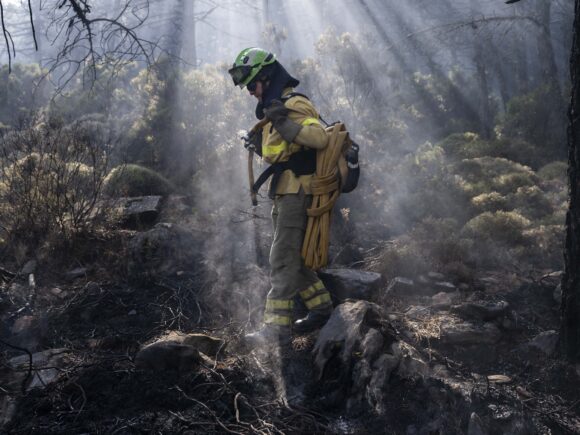MADRID (AP) — Firefighting crews near southern Spain’s Costa del Sol were hoping for much-needed rainfall Monday to help them extinguish a major wildfire that has ravaged 7,700 hectares (19,000 acres) in five days and forced the evacuations of 2,600 people.
Authorities are describing the blaze in Sierra Bermeja, a mountain range in Malaga province, as an extreme “mega-fire” brought on by climate change — a catastrophic event that kill, blacken large areas and is difficult to stop.
In Spain, that’s paired with rural depopulation, leading to poorer management of forests and the accumulation of burnable material.
“We are facing the most complex fire known by the forestry extinction services in recent years,” Juan Sanchez, director of the southern Andalusia region’s firefighting service, told reporters late Sunday.
“We have been talking a lot about the consequences of the abandonment of rural areas and climate change,” Sanchez added. “We are seeing them today.”
The scorched area has doubled since Saturday, when authorities said the flames were contained within a perimeter of 40 kilometers (25 miles). But embers ignited another hot spot soon after, causing a new wildfire that eventually joined the previous blaze, experts said Sunday. By Monday morning, the wildfire’s perimeter had reached 85 kilometers (53 miles).
Spain’s weather agency, AEMET, predicted rain in the arealater Monday but it was not clear if the rainfall would be sufficient to quell the flames.
About 650 firefighters were working in shifts on the ground, assisted by 51 water-dropping airplanes and helicopters. They were joined on Sunday by 260 members of a military emergency unit.
Low visibility due to dust and smoke was blamed for an accident Monday involving a firefighters’ helicopter, although none of its 19 occupants were injured. Another 44-year-old firefighter died Thursday while trying to extinguish the blaze.
Around 2,600 residents have been evacuated. Those who left areas near the resort town of Estepona were able to return home by Monday, but 1,700 people remained displaced from six villages.
Climate scientists say there’s little doubt that climate change from the burning of coal, oil and natural gas is driving more extreme events, such as heat waves, droughts, wildfires, floods and storms.
Spain has experienced fewer fires so far this year than the average, but the number of big forest fires — those affecting more than 500 hectares (1,200 acres) — was 19 in the first eight months of 2021 compared to 14 on average for the same period since 2011.
That has also led to a greater area burned: 75,000 hectares (186,000 acres) as of Sept. 5, compared to an average of 71,000 hectares on average in the previous years, according to official data.
Elias Bedondo, the Andalusia region’s interior minister, said he had no doubt that the wildfire in Sierra Bermeja was “unprecedented” and that it will be studied for future mega-fires.
“Here we are learning how to fight and focus on these sixth-generation type of fires,” he said.
About the photo: A forest firefighter works extinguishing hot spots in a wildfire near the town of Jubrique, in Malaga province, Spain, Saturday, Sept. 11, 2021. Firefighting crews in southern Spain are waiting for much-needed rainfall expected on Monday that they hope can help extinguish a stubborn mega-fire that has ravaged 7,400 hectares (18,300 acres) in five days and displaced some 3,000 people from their homes. (AP Photo/Pedro Armestre)
Was this article valuable?
Here are more articles you may enjoy.


 Hedge Funds Are Hunting Deals in Risks Too Big for Insurers
Hedge Funds Are Hunting Deals in Risks Too Big for Insurers  LA Wildfires Had Little Impact on Reinsurer Risk Appetite During April Renewals
LA Wildfires Had Little Impact on Reinsurer Risk Appetite During April Renewals  CBS Poised to Lose Bid to Stop Sony Taking ‘Jeopardy’ Rights
CBS Poised to Lose Bid to Stop Sony Taking ‘Jeopardy’ Rights  Self-Driving Startup Nuro Raises $106 Million at Lower Valuation
Self-Driving Startup Nuro Raises $106 Million at Lower Valuation 